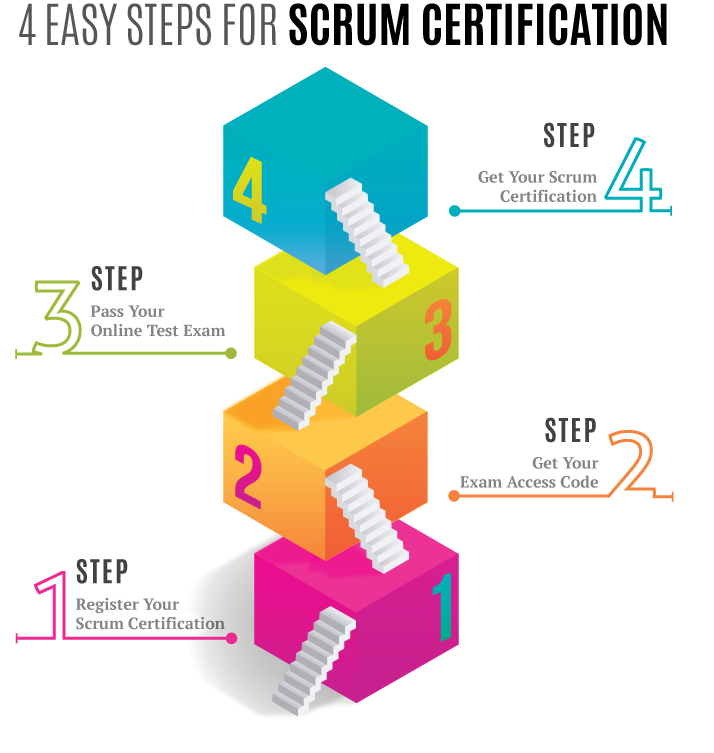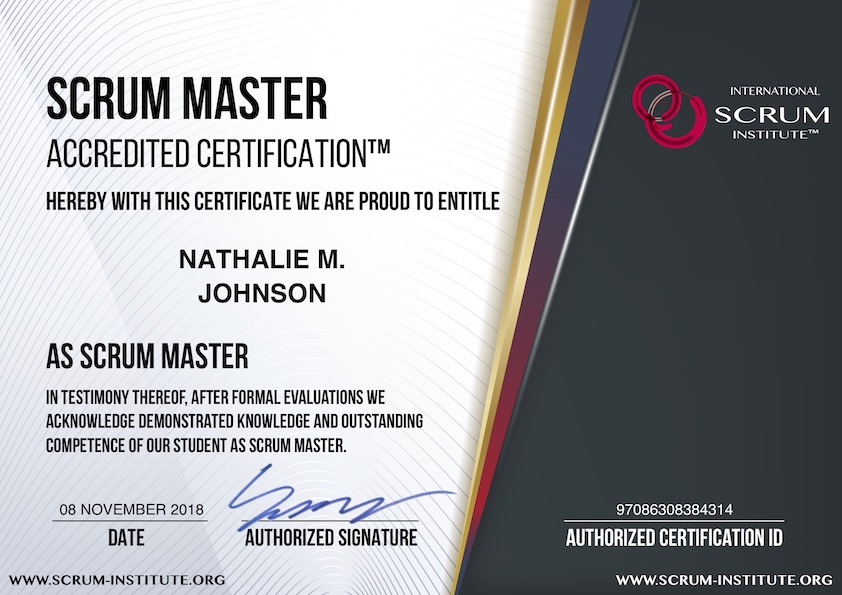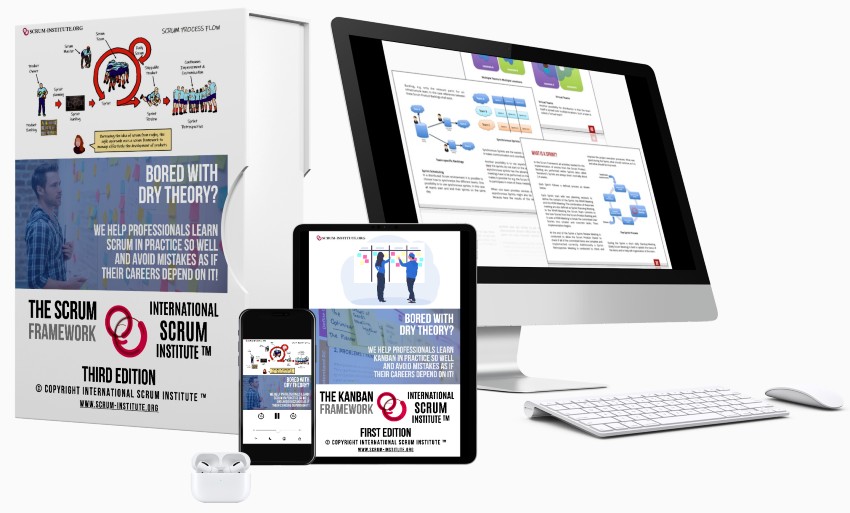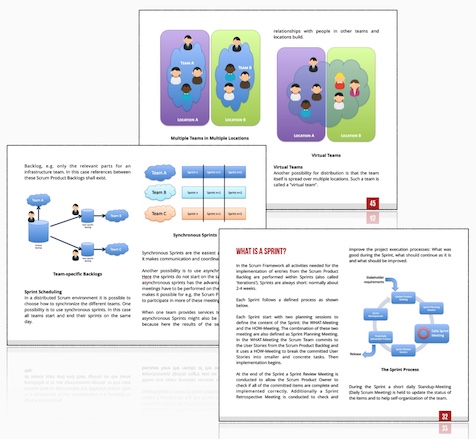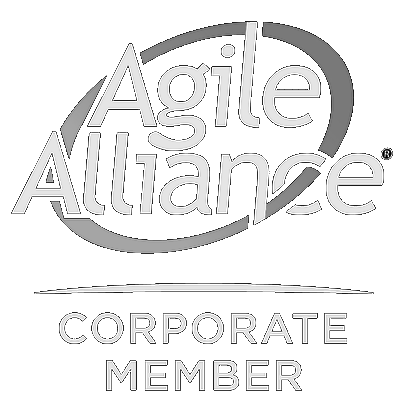Scrum Product Backlog: How Teams Create Value In Agile Projects
Are your Agile projects missing out on their full potential? Perhaps, you're scratching your head, trying to perfect the Scrum approach with the agility of a coach directing a team. It's time you refocus your attention on a component (Main Components of the Scrum Framework) that could be the game-changer: The Scrum Product Backlog. This powerful tool is often underutilized or misunderstood, but mastering it could steer your Agile projects towards surefire success. Are you ready to offer better product delivery through this method? It's a commitment worth making. Join us as we delve into its roles, best practices, and how it can be your ace in project management. Is untapped potential calling your name? Let our experienced trainers guide you through this fascinating series on Scrum Product Backlog together!
Definition: The Scrum product backlog is an ordered list of work items that need to be accomplished to deliver and improve the product in Agile projects. As a coach mentors students in a sport, so does the backlog provide necessary support for the Scrum Team. Effective management of this tool involves regularly refining and prioritizing items, ensuring transparency, aligning with product goals, and using electronic tools to facilitate searching and filtering. It is also important to communicate changes properly when deleting or archiving old tickets to maintain a manageable backlog size.
In the simplest definition, the Scrum Product Backlog is like a series of tasks that need to be done within the project. It replaces the traditional requirements specification artifacts. These items can have a technical nature or can be user-centric. The owner of the Scrum Product Backlog is the Scrum Product Owner (More info about Scrum Product Owner). The Scrum Master, the Scrum Team and other stakeholders, similar to trainers preparing their students, contribute to having a broad and complete To-Do list.
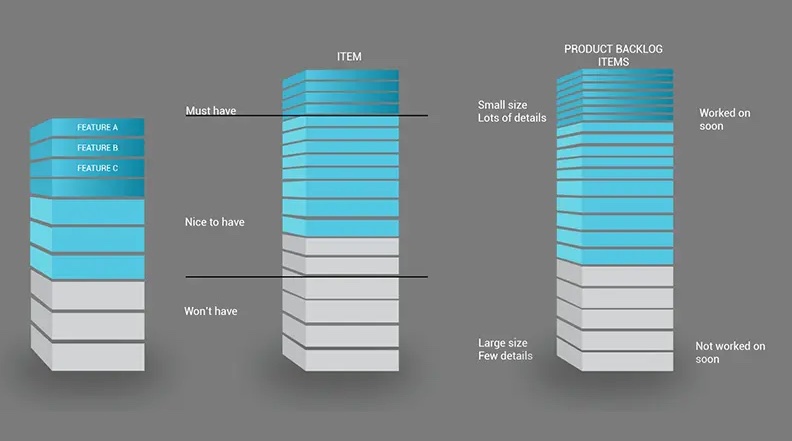 Scrum Product Backlog
Scrum Product Backlog
Working with a Scrum Product Backlog does not mean that the Scrum Team is not allowed to create and use other artifacts. Examples for additional artifacts could be a summary of the various user roles, workflow descriptions, user interface guidelines, storyboards, or user interface prototypes. However, these artifacts do not replace the Scrum Product Backlog but complement and detail its content, displaying a commitment to thorough project development.
The Scrum Product Owner, with the support of the team, uses the Scrum Product Backlog during the Sprint Planning Meeting to describe the top entries to the team. (See our Scrum Example) The Scrum Team then determines which items they can complete during the coming sprint, optimizing product delivery.
Each Scrum Product Backlog has certain properties that differentiate it from a simple to-do list. These properties serve to guide students of the Scrum approach and provide direction, much like a coach driving a team to victory.
- An entry in the Scrum Product Backlog always adds value to the customer.
- The entries in the Scrum Product Backlog are prioritized and ordered accordingly.
- The level of detail depends on the position of the entry within the Scrum Product Backlog.
- All entries are estimated.
- The Scrum Product Backlog is a living document.
- There are no action-items or low-level tasks in the Scrum Product Backlog.
Defining Scrum's Backlog
Every successful agile project has a product backlog at its core, and Scrum is no exception. In simple terms, the product backlog is an ordered list of items (also known as Product Backlog Items or PBIs) that the product development team needs to complete in order to deliver a successful product. In scrum projects, the backlog's importance compares to the commitment of a coach to his students - it is the responsibility of the Product Owner, who prioritizes the work required to ensure effective product delivery.
The backlog contains all items that are known to be required to deliver the product, such as features, bugs, technical debt, knowledge acquisition, etc. It’s an evolving artifact that emerges over time through ongoing feedback loops. Initially it may contain a long list of high-level requirements or Epics. As teams take on each Epic, they will break them down into smaller Stories with more detail and granularity. Each item, then, should be small enough for developers to complete in one sprint, showcasing the agility of the scrum process. The Product Backlog also serves as an integral planning tool within Scrum methodology, aiding the iterative and incremental software development activities. For the software developers and scrum masters involved, it's comparable to a course map outlining the agile leadership strategies required for the development process.
The product backlog is a quintessential component of successful agile projects, including Scrum. It is an ordered list of items that the development team, counted among who are experts in user experience, must complete to deliver a product that meets high standards. The backlog includes all known requirements for the product and evolves over time through feedback loops – case studies often illustrate the critical role it plays. The Product Owner bears the accountability for prioritizing the backlog, ensuring that the necessary work is completed in each sprint. The backlog serves as an integral planning tool for tasks ranging from complex software development to agile leadership courses within the Scrum methodology.
The attention and care that a garden needs for flourishing is akin to the nurturing the backlog requires – it needs to be managed meticulously. At the start of the project, akin to laying out courses, the Scrum Team and its Scrum Product Owner embark by noting down everything they can easily think of. This is almost always more than enough for a first sprint, akin to the sprint a software developer might take on when diving into a new functionality.
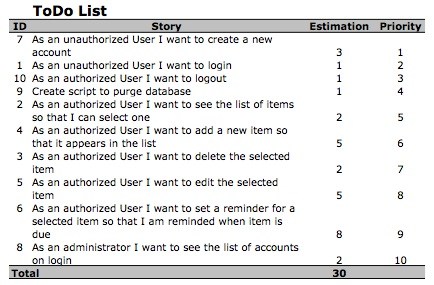 Example Scrum Product Backlog
Example Scrum Product Backlog
Working with the Scrum Product Backlog
The Scrum Product Owner, operating with responsibility and accountability, ensures that the Scrum Product Backlog is in top form, much like a seasoned software developer might ensure the efficiency of his codes – this is a symbiotic process. When using the Scrum Framework, about 10% of the Scrum Team's total time should be reserved for maintaining the Scrum Product Backlog (discussion, estimation etc.), akin to how experts reserve time for professional development courses.
Once this initial setup is complete, the Scrum Product Backlog needs to be maintained in an ongoing process, akin to continuous agile leadership, that comprises the following steps:
- As new items are discovered, they are described and added to the list. Existing ones are changed or removed as appropriate.
- Ordering the Scrum Product Backlog. The most important items are moved to the top.
- Preparing the high-priority entries for the next Sprint Planning Meeting
- (Re-)Estimating the entries in the Scrum Product Backlog
Engaging in the collaborative maintenance of the Scrum Product Backlog not only helps to elucidate the requirements but also creates a buy-in from the Scrum Team, akin to a successful user experience strategy.
Each entry in the Scrum Product Backlog, not unlike elements in a course outline, must boast of some kind of customer value. Entries without any customer value are simply cast aside. The Scrum Product Backlog can include entries for the exploration of both customer needs and various technical options, a spectrum of functional and nonfunctional requests, the work necessary to launch the product, and other items such as environment setup or defect remediation. Like case studies disseminated in a course curriculum, some tasks may not add direct value but secure long-term quality improvement and incident reduction.
Characteristics of Scrum Product Backlog
Only Entries that Add Value
Treated like an agile leadership course open to regular updates, the Scrum Product Backlog is subject to changes throughout the project. If needed, new requirements are added, akin to software developers adding new features, existing ones may be modified, defined in greater detail or even discarded. This dynamic approach contrasts traditional requirements engineering, but allows maximizing customer value and minimizing development effort.
Living List of Items (Living Document)
Much like course outlines taking on different levels of specificity, the requirements in the Scrum Product Backlog also have different granularities. Detailed definitions are reserved for those requirements set for implementation during one of the next sprints, while others remain more general. This is efficient and agile, as it lowers time and effort invested in specifications likely to be altered before implementation starts.
Different Levels of Details
The Scrum Product Backlog, like a blueprint employed by software developers and experts, should not contain detailed requirement information. Ideally, the final requirements are forged together with the customer during the sprint, similar to creating a dynamic user experience based on user feedback. Breakdown and distribution of these requirements is the responsibility of the Scrum Team. They ensure that relevant resources are appropriately allocated, keeping the mission of adding value to the service they are developing in close sight.
No Low-level Tasks
All entries are prioritized and the Scrum Product Backlog is ordered. The Scrum Product Owner, with the help of the Scrum Team, does the prioritization. They treat this process much like grooming, finely tuning priorities based on factors including added value, costs and risks. This iteration of prioritization grants them the velocity required to decide swiftly what should be done next.
The Scrum Product Backlog is Ordered
All the entries within the Scrum Product Backlog have to be estimated according to the agreed definition (e.g. story points). This estimation (See more about Scrum Effort Estimation), similar to preparing a new version of a software, can then be used both to prioritize entries in the Scrum Product Backlog and to plan releases.
All Entries are Estimated
Think of the Product Backlog as similar to preparing for travel - we need to consider packing our bags over time, preparing passports and visas well ahead of schedule, so we ensure smooth execution of our travel plans. The only difference is, here, the travel plans are our service offerings, and the people using these services are our project's stakeholders.
Ownership and Responsibility
The Product Backlog must be established in the early stages of any Agile project. However, ownership and responsibility for maintaining / refining it lies mainly with the Product Owner from then onwards during sprints. Refinement, though not mandatory, can occur at any time during a Sprint and is considered good practice, much like consistently updating the version of an app to increase transparency – provided it doesn’t turn into excessive micromanagement.
Suppose your team has an Agile project where you are responsible for developing an app that displays stock market data in real-time. A version of the app appears to have reduced velocity during high demand. In this iteration of the project, the team should prioritize such issues that require urgent attention, adding it as a specific product item to the backlog, facilitating rapid processing when new data is uploaded.
At times, taking ownership and responsibility for the backlog may seem like an additional burden to product owners. It can feel like grooming a constantly growing task list. Still, it is crucial for them to possess knowledge of the business needs, customer requirements, and align them with software development activities; a mission that seeks to reconcile these diverse elements.
Product backlog management serves as a communication tool across functional groups - facilitating better communications among stakeholders and providing greater transparency of progress towards goals. It's like a service roadmap for all those involved, keeping people updated on what's happening.
Understanding the role of the Product Owner in owning and maintaining a Scrum team's Product Backlog is crucial to keeping momentum and focus. Just like every version of software requires diligent updates, so too does this tool. So, let's now take a closer look at how this works.
In Scrum, a Product Owner has the responsibility of developing and maintaining the Product Backlog on behalf of stakeholders. It is their responsibility to ensure that the product backlog, a central resource in the Scrum process, represents stakeholders’ interests and contains necessary items for the next Sprint. They work in collaboration with stakeholders to understand their needs, identify business goals, and translate them into actionable PBIs. (Product Backlog Items)
- According to the Annual State of Agile Report, over 70% of surveyed organizations favor Scrum or Scrum's hybrid as their agile project management method, indicating the pervasive usage of product backlogs.
- The same report shows that improved team manageability, which includes journeying a well-refined product backlog, is one of the top five reasons for adopting agile practices.
- A study from the Journal of Systems and Software found that successful backlog management led to increased project success rates, in some cases by up to 30%.
Role of the Product Owner
A Product Owner must possess strong leadership skills, vision, clarity about priorities, and have information on hand about the market trends and customer requirements. They should also be able to balance competing demands from different stakeholders while keeping focused on meeting project goals. Ultimately, they are responsible for maximizing the value of the product and service end-users receive.
The rest of the Scrum Team - Development Team and Scrum Master - plays an active role in creating and refining the product backlog. They are the people on the ground, ensuring the mission of the project is adhered to and shaping the iterations based on their valuable resources and insights.The Development Team collaborates with the Product Owner during refinement to discuss scope, feasibility, technical details, and delivery timelines. They work in tandem to formulate solutions that could possibly be infused into the products, thereby enhancing their accuracy and invariably improving their benefits for the human user.
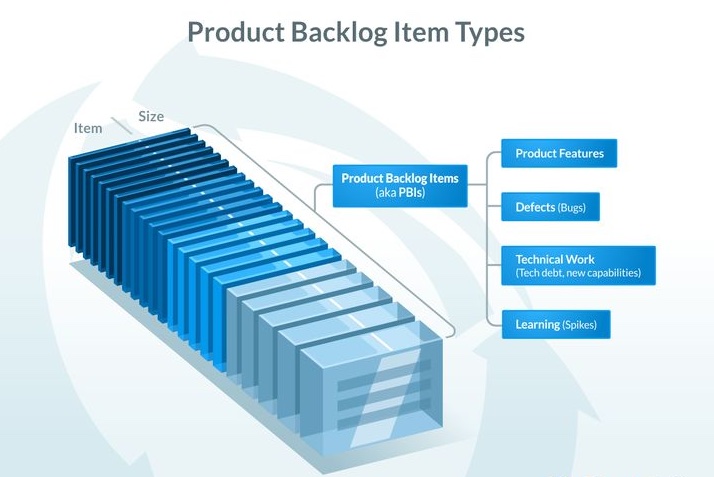 Scrum Product Backlog Item Types
Scrum Product Backlog Item Types
Involvement of the Scrum Team
For example: If a PBI might require significant database modifications, if that’s not viable within a given sprint runway; this information must be communicated by Development Team members so that changes can either be made or its priority adjusted accordingly with stakeholders permission. This process is crucial in several industries, where accuracy and timeliness are paramount for product delivery.
The team members should have complete visibility over all PBIs, including User Stories (See more about Scrum User Stories), technical spikes, bugs reported from testing etc. This visibility helps them gain a better understanding of how each PBI fits into fulfilling upcoming sprint goals within the context of larger project requirements. It provides them with an expanded overview of the production process and the intricacies of the products involved.
The Scrum Master ensures that all refinement ceremonies are conducted regularly according to best practices. They focus on ensuring that the team achieves their targets effectively, tapping into the benefits of synergy and cooperation, all while removing any hindrances to progress.
It's paramount for roles within a Scrum framework to function methodically and interdependently. Here's a breakdown of specific tasks each role plays in the Product Backlog Creation and Refinement, including providing solutions to ensure accurate delivery of final products across diverse industries.
It’s important to emphasize that during product backlog refinement, team members need to strive for a shared, human-centered understanding towards upcoming Sprints goals. If something isn’t clear, then questions should be raised early in refinement instead of waiting until the Sprint starts when it could cause potential delays.
| Product Owner | Scrum Team (Development Team) | Scrum Master |
|---|
| Create the product backlog | Estimate effort required to complete PBIs | Facilitate refinement ceremonies |
| Prioritize PBIs based on business value and stakeholder needs | Break down larger PBIs into smaller, more actionable ones | Ensure the development team communicates PBI details and restrictions clearly |
| Add new user stories or requirements as they arise | Discuss technical feasibility with PO and clarify acceptance criteria | Ensure all team members understand the value and context of all PBIs |
| Remove obsolete items from the backlog and review goals each sprint cycle. | Raise concerns or suggestions regarding scope or feasibility. | Actively participate during refinements. |
If feedback is coming from multiple sources like stakeholders or clients, the onus is on the Product Owner to manage their competing needs while keeping focus on fulfilling user end -goals aligned with the project objective. The Development Team should keep an open line of communication with them to assure that each goal is achievable within current Sprint context.
The Product Backlog is an essential component of any successful Agile project. As such, all members of the Scrum Team actively participate in its creation and refining. Clear communication, transparency, collaboration among the team members are key elements contributing to its successful execution, reaping the benefits of a well-managed production line.
For an Agile project to succeed, its Scrum Team must have a well-defined Product Backlog in place. Not only does this ensure clarity about the process of delivering valuable outcomes, but it also enables stakeholders to have an understanding of the product’s state and growth trajectory. The intricacies of the products and how they fit into the broader objectives is what drives Backlog refinement.
Creation and Refinement Processes
Product Backlog refinement is an ongoing activity where items are broken down and further defined into smaller, more precise items. It’s important to note that refinement can occur at any time during a Sprint and is not mandatory but considered great practice to increase transparency. The refining process helps in creating solutions for industries, thereby accentuating product accuracy and effectiveness.
The process of creating a Scrum Product Backlog begins with establishing requirements. The preparedness of the team and their aligned focus on the end goal adds to the benefits of using this approach, in turn, creating products that meet the demand of the specific industry.
One of the fundamental practices emphasized by scrum teams is regular backlog grooming. Scrum Grooming (Backlog Refinement) Meeting ensures that your backlog is up-to-date, well-prioritized, and ready for your next sprint. It's a cornerstone of an effective Scrum Product Backlog.
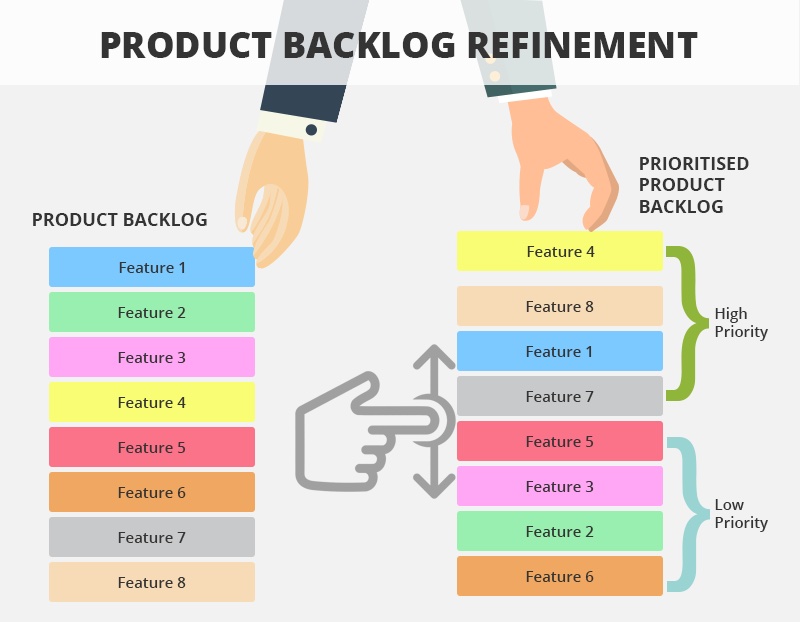 Scrum Grooming (Refinement) Process
Scrum Grooming (Refinement) Process
Establishing Requirements
The process of creating a Scrum Product Backlog begins with establishing requirements. Users’ needs must be analyzed by eliciting their requirements – that is, features or functionality needed – based on their business processes or expected use cases.
Defining clear requirements ensures that the backlog's content aligns with strategic goals towards successful outcome delivery. The "INVEST" method - Independent, Negotiable, Valuable, Estimable, Sized Appropriately, Testable - should be utilized in writing up these requirements.
Requirements can come from various sources - customer inputs through customer feedback surveys and focus groups or stakeholders like CTO/CEO who provide direction on essential non-functional capabilities the system should have. An effective approach going forward with requirement gathering includes using personas or identifying critical use cases as vehicles for bringing real-world scenarios to the project discussions.
Once obtained the Scrum team will then choose specific prioritization techniques to rank these requirements into the product backlog (see next section).
Prioritization Techniques
As mentioned, one of the Scrum Product Backlog's primary objectives is to maximize value for the customer. Therefore, prioritizing those items within the backlog is of the utmost importance. The following techniques may be employed to achieve a more effective outcome:
Imagine having a cupboard full of items and deciding which items you're likely to need in a given week and placing them at the front while pushing less essential items towards the back.
- MoSCoW analysis: A simple model that categorizes items based on "must-have," "should-have," "could-have," or "won't-have" categories.
- Weighted Shortest Job First (WSJF): This method involves calculating the cost of delay, then dividing it by the job size.
- Kano Analysis: Kano Analysis helps prioritize Product Backlog Items (PBIs) by how they'll affect customer satisfaction levels.
- Value Vs. Complexity: This technique involves plotting each PBI's perceived customer value against its complexity as assessed by a multi-functional team.
Prioritizing using any method should involve the utmost collaboration between team members, including stakeholders and customers when necessary.
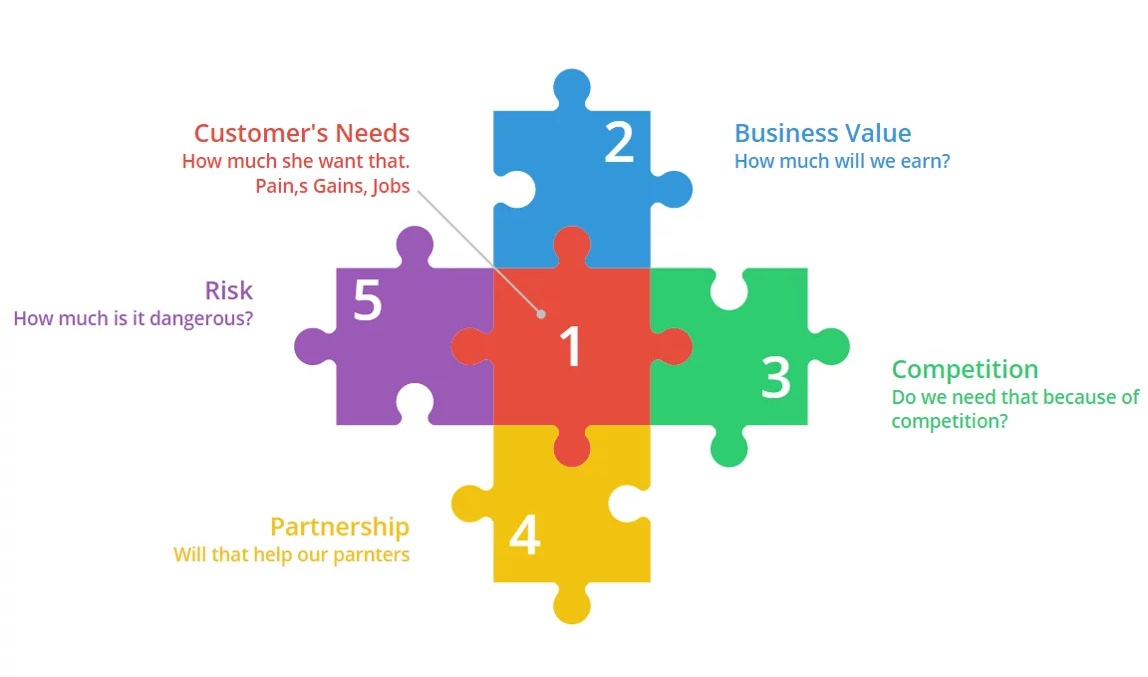 Scrum Product Backlog Prioritization
Scrum Product Backlog Prioritization
Story and Task Formulation
Story formulation is an iterative process, with the goal being to capture what needs to be done from every stakeholder’s perspective. The format is simple yet enough to convey all relevant information in an accessible manner. In contrast, task formulation focuses on determining if all aspects are doable within the prescribed time frame.
Here's an example of user story:
As a <type of user>, I want <some goal> so that <reason>.
The exact phrasing varies depending on the team's needs but always includes who wants something, what they want, and why they want it. These stories are typically written from the end-user perspective and should include as much detail as necessary to ensure that all requirements are met.
Furthermore, once the team has determined the user stories for each PBI, they need to break down these large chunks of work into actionable tasks. This step is where task formulation comes in; it involves taking each PBI and breaking them down into smaller chunks of work that are estimated and completed within a Sprint.
Adaptation and Effective Management
Agile methodology emphasizes continuous adaptation and real-time management techniques. In Scrum, this is achieved through the Product Backlog – an accessible platform where all development tasks are tracked, prioritized, and adjusted as per market feedback. Agile practitioners can leverage input from cross-functional teams to create visible project backlogs that are consistently refined to meet continuously evolving requirements.
Think of it like a living document for your product - constantly changing and growing as you learn more about your customers.
One fundamental principle of effective management in Scrum is transparency, ensuring that every team member has access to the Product Backlog and understands each item's priority order. This facilitates coordination between the Development Team and stakeholders who may provide valuable insights during the Backlog refinement processes.
However, successful delivery in Agile projects requires more than just refining a comprehensive Product Backlog. It demands collaborative efforts between key stakeholders involved in the Sprint Planning process. This brings us to another vital aspect of Scrum: Scoping for Sprints.
Scoping for Sprints
A crucial challenge faced by software development teams using agile methodology is managing potential changes in scope within tight deadlines effectively. Sprint scoping refers to the process of setting project boundaries, identifying deliverables at multiple stages of development, and determining overall timeframes carefully.
For instance, if you estimate that it will take four weeks to deliver a specific feature, split it into two or three smaller features that could be completed within one or two sprints. This way, the team can manage risk better by having small delivery dates, which could signal any potential problems early on.
The work done during sprint scoping should be informed by defined objectives set out via the Product Goal and produced with full participation from critical stakeholders. Identifying a “definition of done” while scoping aids in managing expectations about what needs to be delivered within the sprint timeline.
Success with sprint scoping requires an understanding of the product roadmap and how to balance market demands with realistic timelines. The result is a manageable and predictable approach that aligns well with Agile methodology principles.
Now that we have an idea about scoping for sprints, let's explore adapting to changing priorities in successful Agile Projects.
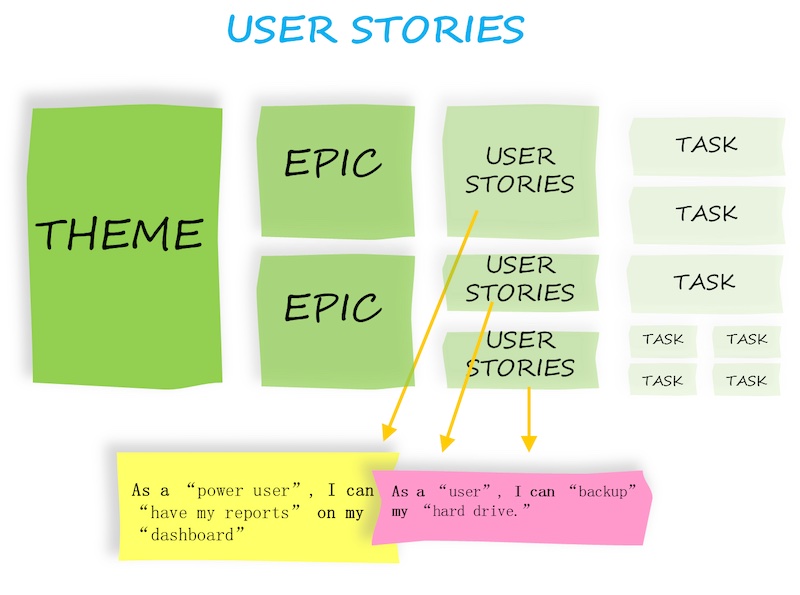 Scrum Product Backlog User Stories
Scrum Product Backlog User Stories
Accommodating Changing Priorities
One of the most significant challenges that stakeholders face in Agile projects is accommodating changing priorities. As a product evolves, new features and requirements may arise that could disrupt the plans laid out during the sprint. This evolution requires continuous monitoring of the project, anticipating changes and ensuring that any re-prioritization does not negatively affect the team's ability to deliver on the product goal.
For instance, consider a team working on developing a website for an online learning platform. One month into development, there could be a realization of the need to add integration with other platforms as part of their feature set. With proper management, this change can potentially enhance product functionality but could disrupt current planned workflows as well.
In such cases, it's best to work towards identifying the desirable change ahead of time by having sprint retrospectives in place. The Scrum Team must anticipate priority changes early to ensure time sufficient for refinement and planning.
Impact on Agile Projects' Success
The success of Agile projects often hinges directly on how effectively stakeholders manage and prioritize items contained within the Product Backlog. A well-structured and managed backlog helps improve project visibility for stakeholders, increases efficiency, and ensures there is enough transparency in relation to progress being made within each sprint.
As a result of its importance, maintaining accurate data regarding higher-value PBIs provides management teams with adequate information that helps identify items that are aligned with both product goals and company strategy, which in turn assures consistent ROI. In addition, preserving a prioritized backlog helps facilitate changes by reducing friction between stakeholders through regular updates on what needs attention.
Hence, creating harmony between individuals eager to make value-based decisions within an Agile environment irrespective of organizational hierarchies through effective communication starts with understanding the importance of the backlog. The Scrum framework enables organizations to have agile development teams that have the ability to collaborate effectively towards a common goal.
Think of the backlog as the steering wheel of your car. While it's essential to have an engine in place (the development team), there needs to be an effective way of controlling the turning for proper navigation.
Product Backlog Q&A for an Agile Team and its Stakeholders
Who prepares the product backlog in Scrum?
In Scrum, the product backlog is typically prepared and managed by the Product Owner. The Product Owner is also responsible for regularly refining and updating the product backlog based on feedback, changing requirements, and evolving priorities. The development team and the Scrum Master may provide input, but the final authority for the content and prioritization of the product backlog rests with the Product Owner.
What is the size of a product backlog in a scrum team?
The size of a product backlog in a Scrum team can vary depending on the complexity and scope of the project. The product backlog is a dynamic and prioritized list of features, enhancements, and fixes that need to be addressed in a product. The size of a product backlog is not fixed and can change throughout the development process, and it is crucial for the team to actively manage and prioritize it to deliver the most value to the customers.
How often should a scrum product backlog be reviewed and updated?
The scrum product backlog should be reviewed and updated regularly, ideally at the start of each sprint during the sprint planning meeting. This ensures that the backlog is always up-to-date with the latest priorities and requirements. According to a study conducted by Agile Alliance, teams that review and update their product backlog more frequently have higher project success rates and improved productivity compared to those who do it less frequently. Therefore, continuous review and updating of the backlog are essential for successful agile projects.
What are some common challenges teams face when managing a scrum product backlog?
Some common challenges teams face when managing a Scrum product backlog include poor prioritization, lack of clear requirements, and stakeholder management. According to a survey conducted by the Project Management Institute (PMI), 38% of project managers identified unclear or changing requirements as a major challenge in Agile projects. Additionally, a study published in the Journal of Systems and Software found that ineffective stakeholder management can lead to conflicts and delays in backlog refinement. These challenges can impact the team's ability to deliver value consistently and efficiently.
What are the key components of a well-maintained scrum product backlog?
The key components of a well-maintained scrum product backlog include a clear and prioritized list of user stories, detailed acceptance criteria for each user story, estimated effort points for each user story, and constant refinement to ensure the backlog remains up-to-date. According to a survey conducted by Scrum Institute, teams that maintain a well-groomed backlog experience 22% higher productivity and are 35% more likely to deliver on time. Thus, maintaining these components is crucial for successful Agile projects.
How is a scrum product backlog different from a traditional project management to-do list?
The scrum product backlog differs from a traditional project management to-do list in several ways. Firstly, the backlog is dynamic and constantly evolving, whereas a to-do list is typically static. Additionally, the product backlog focuses on delivering value to the customer by prioritizing features based on their importance and urgency, while a to-do list may not have this customer-centric approach. According to a study by McKinsey, agile projects that utilize an effective product backlog are 28% more likely to be successful compared to those that rely solely on traditional project management techniques. Therefore, embracing the scrum product backlog can greatly enhance the success rate of agile projects.
What strategies can be used to prioritize items in a scrum product backlog effectively?
There are several strategies that can be used to prioritize items in a scrum product backlog effectively. One effective strategy is using the MoSCoW method, which categorizes items as Must-Have, Should-Have, Could-Have, and Won't-Have for the current release. Another strategy is the business value prioritization technique, where items are ranked based on their potential impact on revenue or customer satisfaction. Additionally, the Kano model can be used to prioritize items based on customer preferences and delighters. Studies have shown that using these prioritization strategies helps teams deliver high-value features faster and improves overall project success rates by up to 30%.
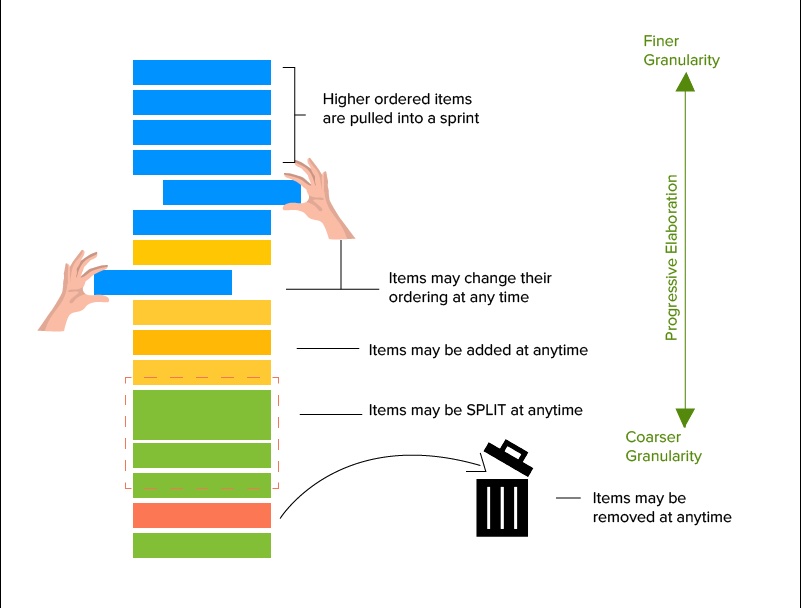 Working with the Scrum Product Backlog
Working with the Scrum Product Backlog
Recap of Scrum Product Backlog in Agile Teams and Product Value
In Agile teams practicing Scrum, the product backlog serves as a dynamic list of prioritized work items, curated by the product owner. This backlog, a key element of the Scrum framework, encapsulates the collective knowledge of the team, stakeholders, and the customer. It outlines the content and scope of the work to be undertaken, providing a transparent roadmap for the team to deliver incremental value. Through continuous refinement and feedback loops, the product backlog ensures adaptability to changing requirements and aligns the team's efforts with the evolving needs of the customer.
Embracing the Scrum product backlog is pivotal for Agile teams committed to delivering customer value efficiently. By maintaining a prioritized list of work items, teams can stay focused on the most impactful tasks, fostering collaboration and maximizing productivity. Continuous learning and adaptation are at the core of the Agile philosophy, urging teams to leverage the feedback loop within the Scrum framework. As teams engage with the product backlog, they not only refine their information and work but also deepen their understanding of customer needs, ensuring a sustainable and value-driven Agile journey.
Stay committed to Scrum practices, and the iterative nature of the product backlog will guide your team towards continuous improvement and success. Thank you very much for reading!
Share It With Your Colleagues and Friends to Help Them Learn:
Scrum Product Backlog: How Teams Create Value In Agile Projects
|
|

|

|

|

|
|
 SCRUM INSTITUTE™
SCRUM INSTITUTE™







